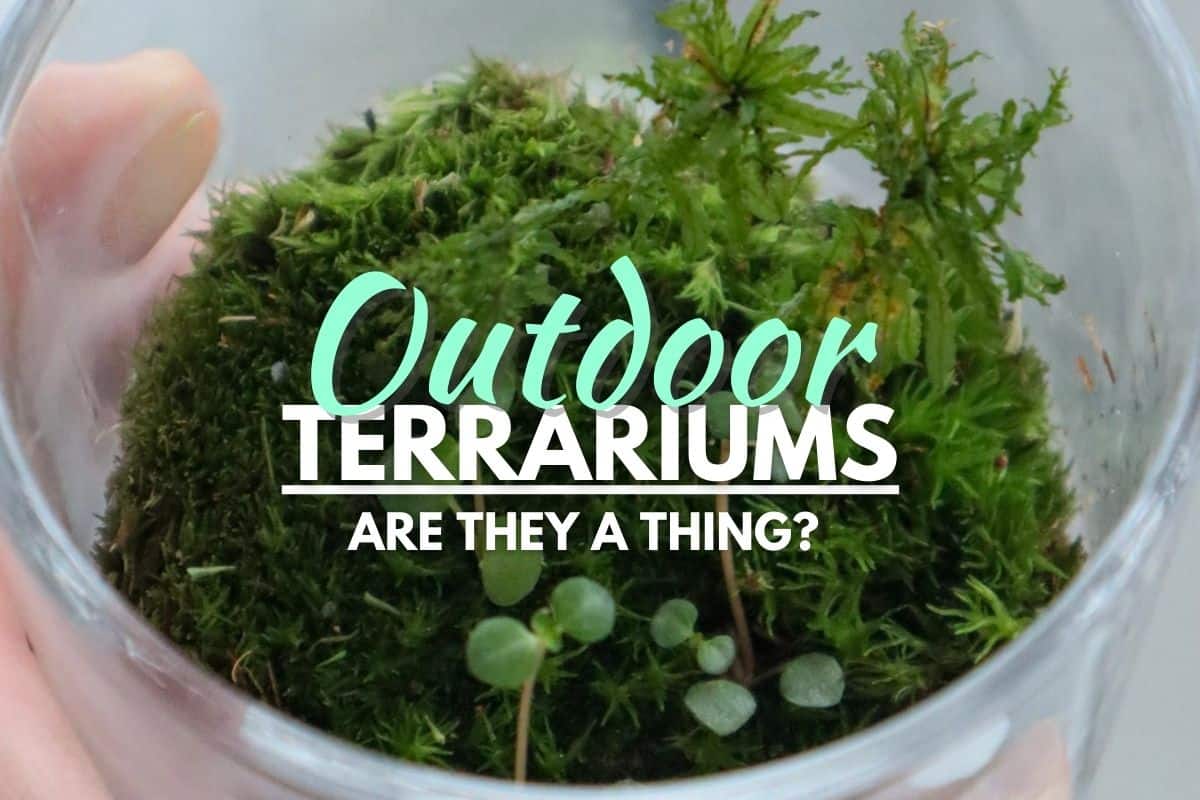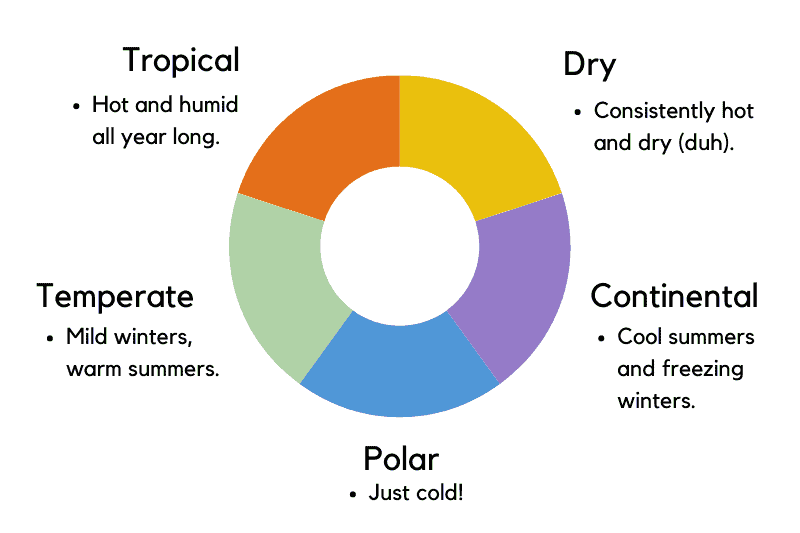Terrariums are designed to create tropical conditions inside the home, for plants that might otherwise struggle in your natural climate.
So then, what happens with a terrarium outside of the home?
Exposed to the elements (and largely outside of our control), keeping an outdoor terrarium brings a whole host of new challenges to consider. After all, the weather is the quintessential thing that’s hard to predict.
So, in this article we’re going to strip down the problem to fully answer the question of whether an outdoor terrarium would work – and how you might go about it.
Let’s dive in!

Terrarium Tribe is reader-supported. When you purchase through links on our site, we may earn an affiliate commission (at no further cost to you). 💜
Can You Keep a Terrarium Outside? – The Quick Answer
You can keep a terrarium outside, provided you either have a stable climate already or have the means to create a terrarium that can buffer any extreme conditions that may arise.
After all, regulating a finely balanced indoor terrarium ecosystem is challenging enough even when you have complete control of your household conditions.
Outside, all of this goes out the window (figuratively and literally).
Not accounting for freak weather conditions, you’ll still have to account for the climate where you live, along with the local ecosystem and the time of day/year.
Quite a lot to consider… But, for those with very consistent weather (California, I’m looking at you), this can be a lot more manageable. For everywhere else that has weather, you’re going to need to create a system and an environment that can buffer a variety of changes (that we’ll get on to in a second).
Thankfully, we do have a few ways to approach things.
Types of Outdoor Terrariums (and Their Uses)
Okay, before we get started with the challenges and solutions, we need to establish which type of terrarium you might want to run with.
You essentially have two options: open or closed.
A closed terrarium is one that’s sealed up and, therefore, able to create its own internal conditions (which can be a double-edged sword when situated outside).
On the other hand, an open terrarium is… exactly what it sounds like. Open and unobstructed, it’s more of a pretty glass pot, really. Which makes it much more straightforward but also impossible to control when it’s outside and open to the elements.
What you choose will be largely dependent on your climate.
- Tropical – In these hot and humid conditions, you can comfortably grow tropical plants in an open terrarium. A closed terrarium would work, but it brings a few additional risks and no benefits.
- Dry – In a hot and dry environment, an open terrarium for arid plants would work well here. However, you could potentially manage with a closed terrarium growing tropical plants if you’re careful in protecting/regulating it.
- Temperate – With mild summers and cool winters, temperate areas aren’t perfectly suited for tropical or arid plants. Open or closed, you’ll need to get hardy plants and be able to manage a range of temperatures and weather conditions. Closed is probably more likely to succeed at buffering those changes.
- Continental – These areas can get very cold winters. So, personally, I don’t see an outdoor terrarium working here.
- Polar – Hah, good luck!

Extra Challenges With an Outdoor Glass Terrarium
1 | Temperature
Glass terrariums tend to be very effective at trapping heat. So, a closed terrarium outdoors that’s fully exposed to the Sun can end up cooking your plants on a hot day.
If you live somewhere like Texas, you can end up with tropical plant stew in no time…
For everyone else, you’d probably still be better off situating your terrarium somewhere that has some shade through the hottest parts of the day. Under a tree or against a wall, maybe.
For the hottest climates, an open terrarium with succulents and cacti would be a better choice. But then, you could just plant them outside?
On the other end of the (temperature) scale, in temperate areas and colder, we’ve got to deal with chilly nights and frosty winters that can spell the end of most terrarium plants. In this case, you’re going to need frosty hardy plants. More on plant choice later.
2 | Sunlight
With great sun comes great responsibility.
Just as excessive heat can spell the downfall of a terrarium, so can excessive sunlight. Not unlike your houseplants, positioning is going to be key in getting the right amount of light.
Tropical plants, on the whole, prefer indirect bright light, and very few can handle full sun for any extended period. So, an outdoor tropical terrarium would really need to go in a bright spot that’s outside of direct sunlight.
Whereas an open arid terrarium could handle (and thrive on) full sun.
3 | Wind and Rain
Heavy rainfall and stormy conditions can pose a variety of challenges to an outdoor terrarium.
The first being flooding.
Typically, we’d be very intentional about how much water we add to a terrarium. An over-saturated substrate can quickly lead to root rot, mold, and disaster. So naturally, a terrarium that’s getting frequent soaking with rainwater won’t last long.
A closed terrarium (that’s fully watertight) can solve this issue, but an open terrarium is just waiting to be filled up. To make matters worse, unlike your garden, an open terrarium wouldn’t have the necessary drainage to get rid of the water.
Not to mention rust, do you have a way to keep the container protected?
Finally, we have the wind itself. Probably the least consistent problem to address, but I guess one big gust is all it takes. You’ll need to make sure your terrarium is anchored or at least well-sheltered.
4 | Pests and Contamination
Generally, pests are not a super common problem with terrariums. They tend to be sealed away from any prying bugs.
But outdoors? It’s anyone’s game.
An open terrarium is essentially part of your local ecosystem and out of your control when it comes to any bugs or bacteria that choose to inhabit it. Though, ecosystems tend to regulate themselves, so it’s not necessarily a bad thing.
A closed terrarium outdoors should still generally be able to maintain its independence from bug invaders, but you’ll have to be extra careful when tending to it. So as to not let anything in.
Outdoor Terrarium Plants
Once again, your choice of outdoor terrarium plants will depend largely on your climate.
If you live in a tropical region, you can go ahead and pick any from this list of closed terrarium plants, and I’m sure you’ll find success.
In a dry climate, you’ll want to stick to arid plants for your open terrarium. There’s a huge variety of succulents and cacti to choose from, so you can really go with what appeals to you most.
However, if your dry climate is still prone to cold nights, you’ll need to choose from the smaller list of cold, hardy succulents.
For temperate areas, you’ll need temperate plants. Temperate moss and fern species are the best bets, in my opinion, as they’re terrarium staples anyway. Asplenium ferns offer a variety of options, as does Rock Ferns or the beautiful Autumn Fern.
Or the likes of English Ivy is virtually indestructible if you’d like a vine option.
Finally, for the truly cold regions, I don’t know, to be honest. Maybe a Christmas Tree?
Key Takeaways
Phew, there’s a lot to consider when it comes to outdoor terrariums, ey?
To be honest, my takeaway from this is that they’re more trouble than they’re worth.
Realistically, only open terrariums have a good chance of working, and even then, it’s only in climates that would naturally support the associated plants anyway.
I think I’ll stick to keeping my terrariums inside, thank you very much.
How about you, are you going to give outdoor terrariums a shot?
